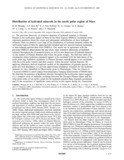| dc.contributor.author | Horgan, B. H. | |
| dc.contributor.author | Bell, J. F. III | |
| dc.contributor.author | Noe Dobrea, E. Z. | |
| dc.contributor.author | Cloutis, E. A. | |
| dc.contributor.author | Bailey, D. T. | |
| dc.contributor.author | Craig, M. A. | |
| dc.contributor.author | Roach, L. H. | |
| dc.contributor.author | Mustard, J. F. | |
| dc.date.accessioned | 2018-03-07T14:40:59Z | |
| dc.date.available | 2018-03-07T14:40:59Z | |
| dc.date.issued | 2009-01-28 | |
| dc.identifier.citation | Horgan, B.H., J.F. Bell III, E.Z. Noe Dobrea, E.A. Cloutis, D.T. Bailey, M.A. Craig, L.H. Roach, and J.F. Mustard (2009) The distribution of hydrated minerals in the north polar region of Mars. Journal of Geophysical Research - Planets, 114, E01005. DOI:10.1029/2008JE003187. | en_US |
| dc.identifier.issn | 2169-9097 | |
| dc.identifier.uri | http://hdl.handle.net/10680/1389 | |
| dc.description.abstract | The previous discovery of extensive deposits of hydrated minerals in Olympia Planum in the north polar region of Mars by the Mars Express OMEGA instrument raises important questions about the origin and subsequent redistribution of these hydrated minerals. Here we present a new map of the distribution of hydrated minerals within the north polar region of Mars by applying both standard and new spectral analysis techniques to near-infrared spectral data from OMEGA. Our results are in agreement with the
previous OMEGA observations but also show more extensive detections of hydrated minerals throughout the circumpolar plains, as well as new detections of hydrated minerals on the surface of Planum Boreum and within the polar troughs. We find that while the circumpolar plains hydration signatures appear to be correlated with the dark dunes of the north polar erg, hydration signatures in Planum Boreum instead appear to be correlated with the north polar veneers and their sources within the polar layered deposits. By applying laboratory-derived empirical models of the dependence of gypsum spectra on grain size and abundance, we provide approximate abundance estimates for the hydrated minerals we have identified in Observatoire pour la Minéralogie, l’Eau, les Glaces et l’Activité (OMEGA) and Compact Reconnaissance Imaging Spectrometer (CRISM) data. We find that the presence of hydrated minerals throughout the north polar region suggests (1) a complex cycle of sediment exchange between the Olympia Planum dunes and the other polar units; (2) an earlier origin for the hydrated minerals than originally postulated; and (3) the occurrence of significant water activity in this region during the Amazonian. | |
| dc.description.sponsorship | This work was supported by grants from the Mars Data Analysis Program under contracts from NASA,
the Mars Odyssey Participating Scientist program under contracts from the Jet Propulsion Laboratory, and the Canadian Space Agency. | |
| dc.description.uri | https://agupubs.onlinelibrary.wiley.com/doi/abs/10.1029/2008JE003187 | |
| dc.language.iso | en | en_US |
| dc.publisher | Journal of Geophysical Research | en_US |
| dc.rights | info:eu-repo/semantics/openAccess | |
| dc.title | Distribution of hydrated minerals in the north polar region of Mars | en_US |
| dc.type | Article | en_US |
| dc.identifier.doi | 10.1029/2008JE003187 | |

